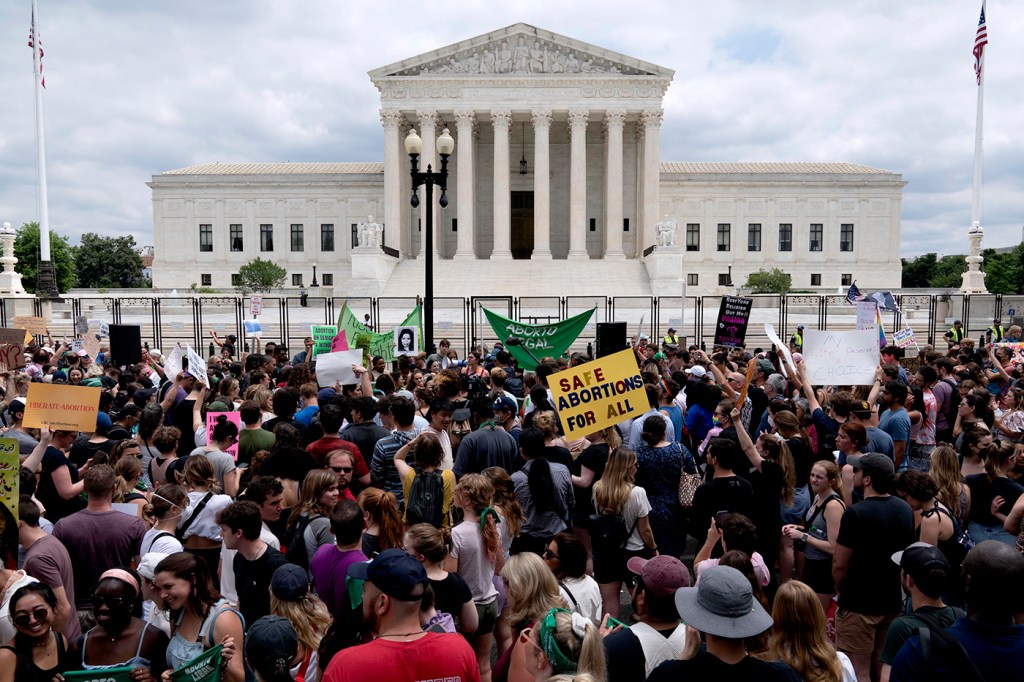Northeastern faculty experts react to Roe v. Wade decision

The U.S. Supreme Court, in a ruling that many abortion rights advocates have long-dreaded would become a reality, has overturned Roe v. Wade—the landmark 1973 decision that established, codified, and protected a person’s right to have an abortion.
Friday’s decision, which all but mirrored a draft opinion leaked months earlier, saw five conservative justices—Samuel Alito Jr., Clarence Thomas, Neil M. Gorsuch, Brett M. Kavanaugh, and Amy Coney Barrett—sign on to an opinion, authored by Alito, to overturn Roe. Chief Justice John Roberts voted in the majority, but did not share the majority opinion. Justices Stephen Breyer, Sonia Sotomayor, and Elena Kagan dissented, making the overall vote 6-3 along party lines.
The ruling is part of the High Court’s review of Dobbs v. Jackson Women’s Health Organization, a case over a Mississippi law that sought to ban most abortions after 15 weeks.
“Roe was egregiously wrong from the start,” Alito wrote. “Its reasoning was exceptionally weak, and the decision has had damaging consequences. And far from bringing about a national settlement of the abortion issue, Roe and [Casey v. Planned Parenthood] have enflamed debate and deepened division. It is time to heed the Constitution and return the issue of abortion to the people’s elected representatives.”

As outlined, the ruling sends the matter of abortion back to the states, which now get to regulate the practice as they see fit. More than a dozen states have already implemented so-called “trigger laws” with partial or complete abortion bans that will take effect in the coming days. It appears more states will look to enact restrictions as well. Others have enacted state laws or constitutional amendments protecting abortion access.
The conservative majority’s reasoning rested on the fact that the Constitution “makes no mention of abortion,” writing that Roe’s reasoning was without reference to “constitutional text, history, or precedent.” But the purpose of the Constitution, insofar as it grants and protects basic rights and liberties, should be understood in relation to “what the text is trying to accomplish,” not “what’s actually in the text,” argues Jeremy R. Paul, a professor of law and former dean of Northeastern’s School of Law.
With its decision, Paul says the Supreme Court has now “repoliticized the question of abortion in every state.” The ruling also adds another political dimension to this year’s midterm elections, providing Republicans with incentive to further restrict abortion through a federal ban, should they gain a majority of seats in Congress. State legislatures across the country will now become battlegrounds for efforts to protect or restrict abortion access.
“This decision does not respect the founding principle of the country, which is freedom of conscience,” Paul says. “That’s why we have the 9th Amendment; that’s why we have a religious clause; that’s why we have a Bill of Rights.”
Paul continued: “I see this approach to the Constitution as highly un-American. It doesn’t take into account what kinds of decisions should be made by the government, and what kinds of decisions should be made by individuals. The whole point of the Constitution is to take whole questions of morality and leave them with the individual. Now, the government can effectively point a gun to a pregnant woman’s head and say, ‘You can’t have an abortion.’”
Experts worry that, because Roe relied on a right-to-privacy framework that is not explicitly mentioned in the Constitution, other precedents that use that same framework could soon fall to legal challenges, so long as the ideological makeup of the High Court remains the same. They include Griswold v. Connecticut, establishing the right of married couples to use contraception; Lawrence v. Texas, making same-sex sexual activity legal across the country; and Obergefell v. Hodges, establishing the right of gay couples to marry.
In fact, Justice Thomas wrote in a concurring opinion that the court should reconsider all three of those decisions.
“As a matter of legal reasoning, [the conservative Justices] call into question the basis for a whole host of decisions with this ruling,” says Martha F. Davis, university distinguished professor of law at Northeastern, who teaches constitutional law and human-rights advocacy.
“It’s very maddening to see the majority of the court embrace that view,” Davis added, saying it effectively makes women into “second-class citizens.”
Davis says that the ruling also opens the door for states to “redefine what they think abortion even means,” further limiting access to contraceptive care.
“What we’re seeing is the lawless overruling of women’s rights and long-standing precedent,” Davis says.
For media inquiries, please contact media@northeastern.edu
